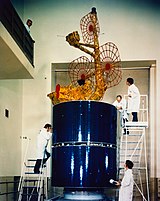
The Atlas-Centaur was a United States expendable launch vehicle derived from the SM-65 Atlas D missile. The vehicle featured a Centaur upper stage, the first such stage to use high-performance liquid hydrogen as fuel. Launches were conducted from Launch Complex 36 at the Cape Canaveral Air Force Station (CCAFS) in Florida. After a strenuous flight test program, Atlas-Centaur went on to launch several crucial spaceflight missions for the United States, including Surveyor 1, Mariner 4, and Pioneer 10/11. The vehicle would be continuously developed and improved into the 1990s, with the last direct descendant being the highly successful Atlas II.
The Intelsat VI series of satellites were the 8th generation of geostationary communications satellites for the Intelsat Corporation. Designed and built by Hughes Aircraft Company (HAC) in 1983-1991, there were five VI-series satellites built: 601, 602, 603, 604, and 605.

Marisat satellites were the first maritime telecommunications satellites and were designed to provide dependable telecommunications for commercial shipping and the U.S. Navy from stable geosynchronous orbital locations over the three major ocean regions. The three Marisat satellites, F1, F2, and F3, were built by Hughes Aircraft Corporation (HAC) for COMSAT Corporation starting in 1973. The satellites were designed to provide maritime telecommunications services in three large ocean areas, the Atlantic Ocean, the Pacific Ocean, and the Indian Ocean, and were located at 72.5° East longitude, 176.5° E, and 345° E in the geosynchronous orbital arc. The three-satellite Marisat system served as the initial INMARSAT constellation.
Intelsat IV F-1 was a geostationary communication satellite built by Hughes, it was owned by Intelsat. The satellite was based on the HS-312 platform and its estimated useful life was 7 years.
Intelsat III F-4 was a geostationary communications satellite built by TRW, it was owned by Intelsat, a company currently based in Luxembourg. The satellite had an estimated useful life of 5 years.
Intelsat IV F-2 was a geostationary communication satellite built by Hughes and owned by Intelsat. The satellite was based on the HS-312 platform and its estimated useful life was 7 years.

Intelsat IV F-3 was a geostationary communication satellite built by Hughes, it was owned by Intelsat. The satellite was based on the HS-353 platform and its estimated useful life was 7 years.
Intelsat IV F-4 was a geostationary communication satellite built by Hughes, it was owned by Intelsat. The satellite was based on the HS-312 platform and its estimated useful life was 7 years.

Intelsat IV F-5 was a geostationary communication satellite built by Hughes, it was owned by Intelsat. The satellite was based on the HS-312 platform and its estimated useful life was 7 years.
Intelsat IV F-7 was a geostationary communication satellite built by Hughes, it was owned by Intelsat. The satellite was based on the HS-312 platform and its estimated useful life was seven years.
Intelsat IV F-8 was a geostationary communication satellite built by Hughes, it was owned by Intelsat. The satellite was based on the HS-312 platform and its estimated useful life was 7 years.

Intelsat IVA F-2 was a geostationary communication satellite built by Hughes, it was owned by Intelsat. The satellite was based on the HS-353 platform and its estimated useful life was 7 years.

Intelsat IVA F-1 was a geostationary communication satellite built by Hughes, it was owned by Intelsat. The satellite was based on the HS-353 platform and its estimated useful life was 7 years.

Intelsat IVA F-3 was a geostationary communication satellite built by Hughes, it was owned by Intelsat. The satellite was based on the HS-353 platform and its estimated useful life was 7 years.

Intelsat IVA F-4 was a geostationary communication satellite built by Hughes, it was owned by Intelsat. The satellite was based on the HS-353 platform and its estimated useful life was 7 years.

Intelsat IVA F-6 was a geostationary communication satellite built by Hughes, it was owned by Intelsat. The satellite was based on the HS-353 platform and its estimated useful life was 7 years.
Intelsat V F-6, then named Intelsat 506, was a communications satellite operated by COMSAT. Launched in 1983, it was the sixth of fifteen Intelsat V satellites to be launched. The Intelsat V series was constructed by Ford Aerospace, based on the Intelsat V satellite bus. Intelsat V F-6 was part of an advanced series of satellites designed to provide greater telecommunications capacity for INTELSAT's global network.
Intelsat 509, previously named Intelsat V F-9, was a communications satellite operated by Intelsat. Launched in 1984, it was the ninth of fifteen Intelsat V satellites to be launched. The Intelsat V series was constructed by Ford Aerospace, based on the Intelsat-V satellite bus. Intelsat V F-9 was part of an advanced series of satellites designed to provide greater telecommunications capacity for Intelsat's global network. He also carried a Maritime Communications Services (MCS) package for Inmarsat. However, the launch vehicle failed to put the satellite into a useful orbit.
Intelsat VA F-11, then named Intelsat 511, was a communications satellite operated by Intelsat. Launched in 1985, it was the eleventh of fifteen Intelsat V satellites to be launched. The Intelsat VA series was constructed by Ford Aerospace, based on the Intelsat VA satellite bus. Intelsat VA F-11 was part of an advanced series of satellites designed to provide greater telecommunications capacity for Intelsat's global network.
Intelsat 706 is a geostationary communication satellite that was built by Space Systems/Loral (SSL). It is located in the orbital position of 157 degrees east longitude and it is currently in an inclined orbit. The same is owned by Intelsat. The satellite was based on the LS-1300 platform and its estimated useful life was 15 years.




